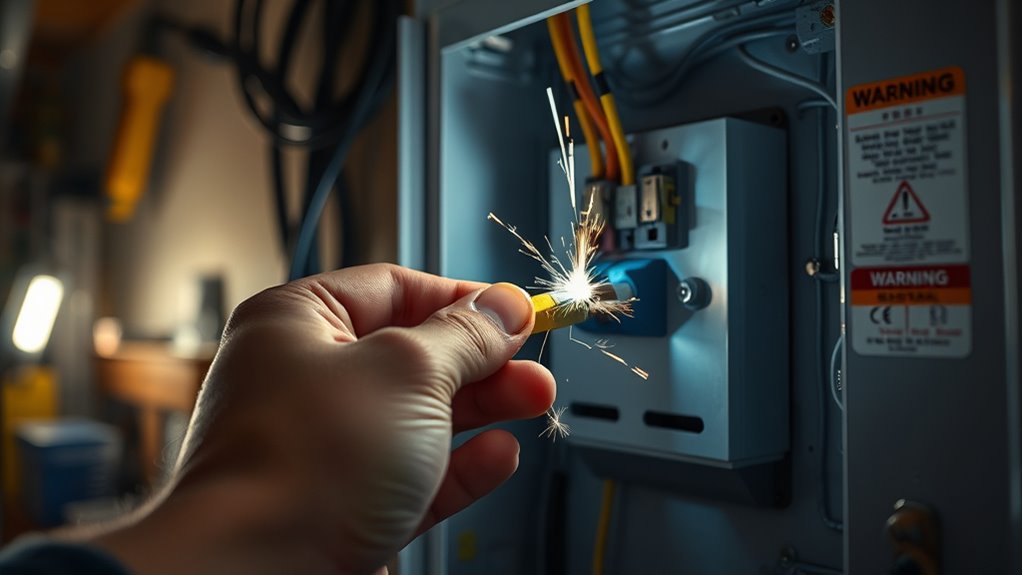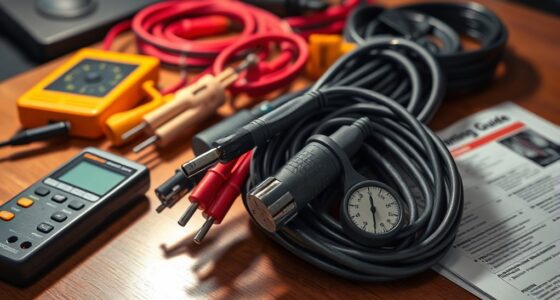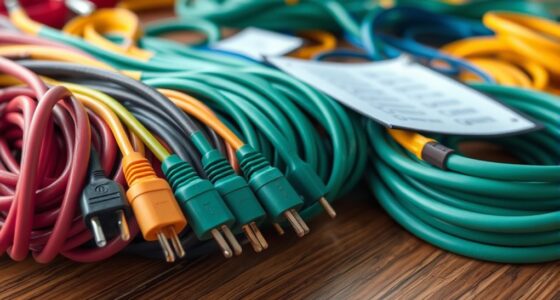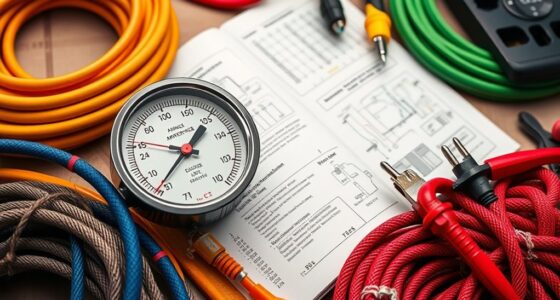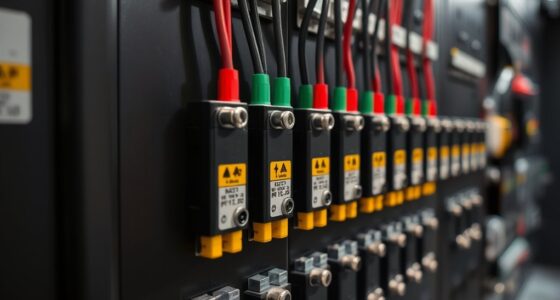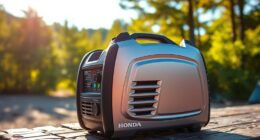Backfeeding happens when generator power flows back into your home’s wiring during an outage, which can energize power lines and cause serious dangers. It risks electrical shocks, fires, and even injuries to utility workers working nearby. Incorrect connections or failing to use proper devices like transfer switches make this more likely. To stay safe, it’s essential to understand how to prevent backfeeding and use safe power alternatives. Keep exploring to learn how to protect yourself and others effectively.
Key Takeaways
- Backfeeding occurs when generator power flows back into home wiring, risking electric shocks and fires.
- Proper circuit isolation, like using transfer switches, prevents backfeeding and protects utility workers.
- Connecting a generator without proper safety measures can energize power lines, endangering utility personnel.
- Regular maintenance and following safety protocols ensure safe generator operation and reduce backfeeding risks.
- Using safe alternatives (solar, batteries, UPS) during outages minimizes hazards associated with generator backfeeding.
What Is Backfeeding and How Does It Work?

Have you ever wondered how backfeeding happens during a power outage? It occurs when electricity from a generator flows back into your home’s wiring, potentially energizing power lines and endangering utility workers. To prevent this, generator safety protocols emphasize circuit isolation—disconnecting your home from the grid before connecting a generator. Proper circuit isolation ensures that backfeeding doesn’t occur, keeping everyone safe. When you connect a generator without isolating circuits, the power can travel backwards through the wiring, posing serious risks. Always follow manufacturer instructions and local codes to ensure your setup prevents backfeeding. Understanding how backfeeding works highlights the importance of using appropriate safety measures during generator use, protecting both your household and utility workers. Additionally, using a transfer switch can help eliminate the risk of backfeeding altogether by safely switching your power source.
The Hidden Dangers of Backfeeding to Your Home
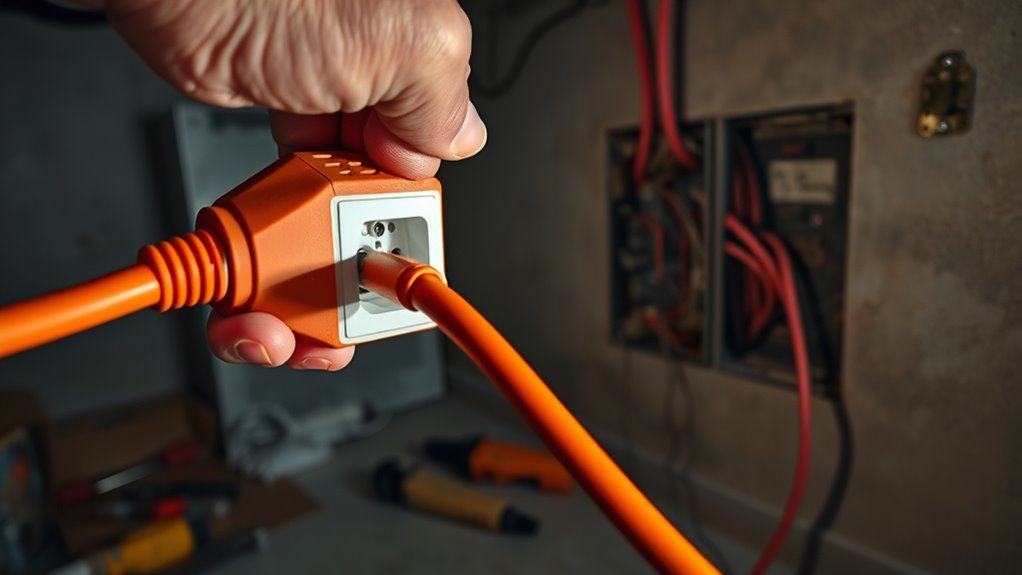
Backfeeding your home can pose serious safety risks you might not see right away. It increases the chance of electrical shocks if you touch faulty wiring or equipment. Additionally, it can create fire hazards that threaten your home and everyone inside. Implementing proper safety measures can help prevent these dangerous situations. Best airless paint sprayer
Fire Hazard Risks
While backfeeding might seem like a quick fix during power outages, it substantially increases the risk of fires in your home. Without proper generator safety and circuit protection, you risk overloading circuits or igniting wires.
Here are four fire hazard risks to watch out for:
- Overloaded circuits that cause overheating and sparks.
- Inadequate circuit protection, which can fail to disconnect the power during faults.
- Faulty wiring connections that generate heat and ignite surrounding materials.
- Unintended backflow of electricity into the grid, increasing fire risk for utility workers and neighbors.
Proper generator safety measures and circuit protection are essential to prevent these hazards. Never ignore fire risks associated with backfeeding, and always follow safety protocols. Additionally, the use of self-watering planters can help reduce electrical hazards by minimizing the need for frequent watering that could potentially lead to water-related electrical issues in the home.
Electrical Shock Potential
Even though backfeeding might seem like a convenient way to restore power during outages, it poses a significant risk of electrical shock if not done correctly. When you backfeed, there’s a potential for a ground fault, where electricity finds an unintended path to the ground, increasing shock risk. If the circuit breaker isn’t properly rated or fails to trip during a ground fault, you could be exposed to live electrical current. This danger is especially real if you touch a metal appliance or wiring connected to the backfeed. Proper safety measures, like installing a transfer switch and ensuring your circuit breaker functions correctly, are essential to prevent accidental shocks. Additionally, using well-maintained electrical equipment helps reduce the risk of faults and enhances safety. Always prioritize safety and consult an electrician before attempting any backfeeding procedures.
Risks to Utility Workers During Backfeeding
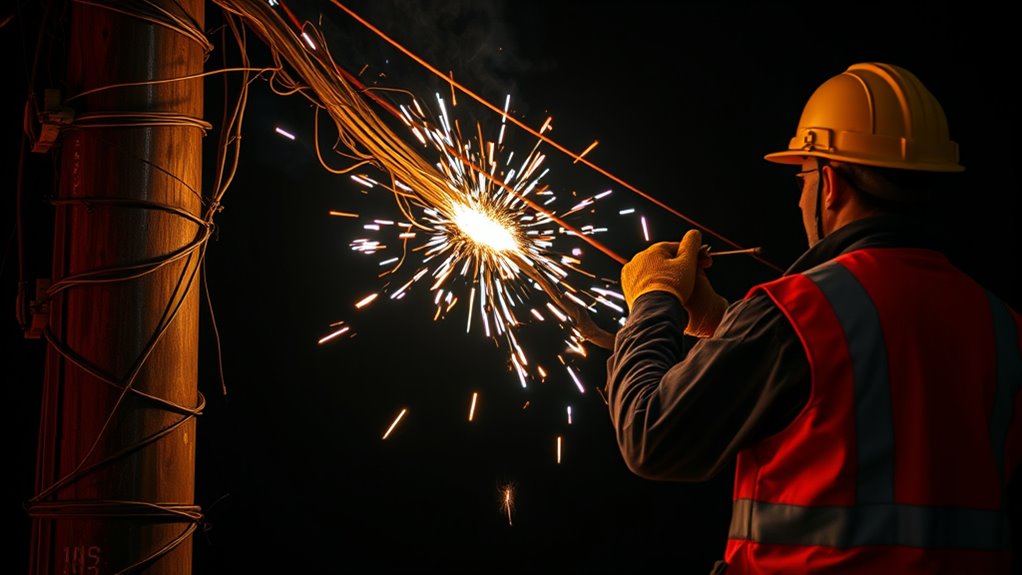
Utility workers face significant dangers when performing backfeeding operations, especially if proper procedures aren’t followed. The risks to utility worker safety are real and can result in severe injury or death. Without proper backfeeding training, you might underestimate hazards like live lines or unexpected power flow. Here are four critical risks to watch for:
Utility workers face serious dangers during backfeeding; proper training is essential for safety.
- Electrocution from unexpected live circuits
- Falling due to unstable work surfaces or equipment
- Contact with energized equipment during setup or disassembly
- Injury from equipment malfunctions or improper grounding
Understanding proper backfeeding procedures is essential to mitigate these dangers and ensure safety during operations. To protect yourself, always follow safety protocols and ensure thorough backfeeding training. Recognizing these dangers helps you stay alert and prepared, reducing the likelihood of accidents during backfeeding operations. Your safety depends on strict adherence to proper procedures.
Common Mistakes That Lead to Dangerous Backfeeding

Many accidents during backfeeding happen because workers make common mistakes that could be easily prevented. One major mistake is neglecting proper generator safety protocols, which can lead to dangerous backfeeding into utility lines. Failing to ensure circuit isolation is another critical error; without isolating circuits properly, electricity can flow back into the grid, risking shock or fire. Always verify that your generator is disconnected from the utility system before powering it on. Using proper switching devices and double-checking connections helps prevent backfeed hazards. Overlooking these safety steps increases the chance of injuring yourself or utility workers. Remember, careful attention to circuit isolation and generator safety measures is essential to avoid these common, dangerous mistakes. Additionally, understanding the importance of power quality and proper system setup can further reduce risks associated with backfeeding.
Safe Alternatives to Power Your Home During Outages

During power outages, choosing safe and reliable alternatives to keep your home running is essential. Proper generator safety is vital to prevent accidents and carbon monoxide poisoning. Consider installing battery backups, which are simple and quiet solutions for essential devices. Here are some safe alternatives:
- Portable Generators – Use only outdoors and follow safety instructions.
- Battery Backups – Power critical electronics without fuel or emissions.
- Uninterruptible Power Supplies (UPS) – Protect computers and sensitive equipment.
- Solar Power Systems – Eco-friendly and silent, providing backup during outages.
Being aware of simple ways to foster kindness and positive change can also help you stay calm and supportive during stressful situations like power outages.
Tips for Staying Safe When Managing Emergency Power
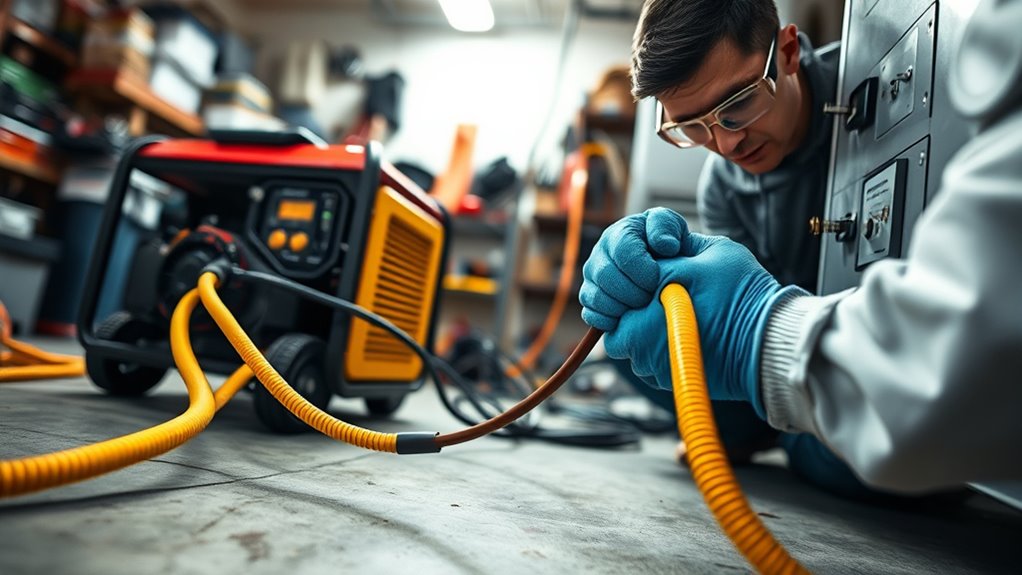
Managing emergency power safely requires staying alert and following proper procedures at all times. Prioritize generator safety by keeping it outdoors, away from windows and vents, to prevent carbon monoxide buildup. Always read the manufacturer’s instructions before operating your generator, and never overload it—this can cause dangerous electrical issues. During an outage, ensure your emergency preparedness plan includes clear steps for safely powering essential appliances. Use heavy-duty extension cords rated for outdoor use, and avoid plugging multiple devices directly into the generator’s outlets. Before refueling, turn off the generator and let it cool down to prevent fires. Staying vigilant and adhering to safety guidelines minimizes risks, protects your household, and ensures you’re prepared to manage emergency power effectively. Additionally, understanding the importance of proper generator maintenance can help prevent malfunctions and ensure reliable operation when needed.
Frequently Asked Questions
Can Backfeeding Cause Damage to Electrical Appliances?
Yes, backfeeding can cause damage to your electrical appliances. When power flows backward through your system, it can lead to electrical surges that overload your devices. These surges might fry sensitive components or shorten the lifespan of your appliances. To prevent this, avoid backfeeding and guarantee proper safety measures are in place. Protect your appliances by using surge protectors and consulting a licensed electrician for safe setup.
Is Backfeeding Legal in Residential Areas?
You might think backfeeding is a shortcut, but it’s like playing with fire in residential areas. Legally, it’s often prohibited because it compromises generator safety and violates electrical codes. Authorities want to prevent accidents and ensure everyone’s safety. Before attempting to backfeed, check your local regulations and consult a licensed electrician. Following proper procedures maintains your home safe and keeps you within the bounds of the law.
How Can I Identify if My Home Is Backfeeding?
You can identify if your home is backfeeding during a power outage by checking your generator hookup. If your generator is connected directly to your home’s wiring without a proper transfer switch, backfeeding might occur. Turn off all appliances, then carefully inspect your setup. If you notice power flowing into your home’s circuits while the main breaker is off, you’re backfeeding. Always use a qualified electrician to verify and prevent hazards.
What Tools Are Necessary to Prevent Backfeeding Accidents?
You should use a circuit breaker lockout device to prevent accidental backfeeding. Installing safety devices like transfer switches or interlock kits is essential for safe generator connection. These tools guarantee your generator doesn’t feed power back into the grid, reducing shock risks. Always verify your equipment’s compatibility and follow manufacturer instructions. Regularly inspect and maintain these safety tools to keep your home protected during power outages.
Are There Specific Signs Indicating Backfeeding Issues?
Did you know that nearly 15% of electrical accidents happen during power outages or overloads? If you notice flickering lights, frequent breaker trips, or unusual humming sounds, these could be signs of backfeeding issues. During a power outage or electrical overload, backfeeding can cause dangerous voltage to flow back into your system, so stay alert to these warning signs to prevent accidents and guarantee safety.
Conclusion
Understanding backfeeding is essential to keep yourself and utility workers safe. By knowing the risks and choosing safe alternatives, you can avoid accidents and power outages turning into disasters. Remember, don’t try to be a hero like in old-time movies—always prioritize safety and follow proper procedures. When in doubt, call a professional. Stay vigilant, stay safe, and keep your home powered without risking a trip to the emergency room!
